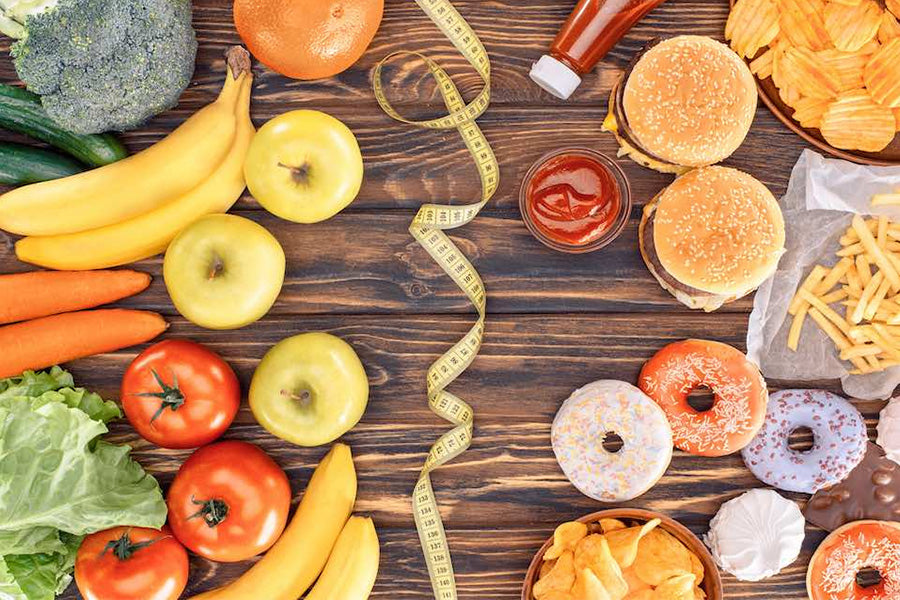Want to lose weight but don't feel like giving up on your favourite food? Yes, that's possible! You can still lose weight while chugging down a big mac. The secret? Flexible dieting!
Also called IIFYM (If It Fits Your Macros), this simple dieting technique is gaining popularity among all health and fitness enthusiasts. The most remarkable thing about it is that it does not deprive the dieter of their favourite food, even if it is considered "dirty" in other diet forms. No need to be the odd one out next time your gang eats out because you're on a diet: trot along and have fun without feeling guilty: this is the magic of a flexible diet program.
So are you ready to unravel the secrets of losing weight or gaining muscles with this amazing technique? Keep reading as we are going to share every detail.
What is Flexible Dieting?

Flexible dieting means weight loss or muscle gain using the total count of your macronutrients and calorie needs and never exceeding that count. The exact number of calories your body needs and your macro count decide how much food you can have every day.
Flexible Dieting is nothing like your traditional diet. Instead of controlling the amount of food, it focuses on food composition, like what macronutrients, micronutrients, and dietary fiber are in there and in what proportion. It gives a practical solution to dieting, which is sustainable and manageable in the long term.
To start this program, you will need to figure out the exact caloric consumption and macronutrients required by your body. Once you know these two things, you know how much food you can eat every day and what macros proportion. There are no complications regarding food portions or macros' calculation.
What makes flexible dieting so "flexible" is the 80/20 Rule, Which means 80% or so of your daily intake is nutrient-dense, healthy, organic, whole and minimally processed foods while the rest 20% or so are is your fun dose allowing you to mix and match a variety of foods in your diet. This allows for a more sustainable long-term approach. You can enjoy healthy foods, fuel your body with the best of nature’s gifts and still never have to look at junk/fast food and feel helpless!
Sounds simple, doesn't it? Let’s learn how to ace flexible dieting and do it properly!
Benefits of Flexible Dieting
IIFYM or flexible dieting is not just a diet plan. Instead, it is more of a lifestyle and an old one. We've been familiar with the concept of controlled eating all our lives. The best thing is that it suits human nature - eat little, but eat what your taste buds want.
Here's why flexible dieting is the healthy way to achieve a better physique:
No Food Restrictions
You've heard it before, but here is a reiteration; flexible dieting means you can eat whatever you want. As long as you don't go crazy with the quantity, the quality of the food doesn't matter here.
For example, a flexible dieting layout encourages you to eat a chargrilled chicken sandwich for lunch, plus a diet soda, if you stick with the calorie deficit plan you calculated at the start of the diet. How cool is that!
Easy-To-Follow
A diet excessively rigid on your food options is not easy to carry on for a long time. The human mind needs to fall back to its comfort zone every once in a while. That is why strict diets see a lot of failures. People start them with lots of hope and zeal, only to fall back on their old routine in no time.
Flexible dieting makes much more sense, especially if you are a sweet tooth or someone who loves fried food. Because where else will you be allowed to eat donuts to lose weight?
You do not have to deprive yourself or restrict intake excessively. These factors make it easy to follow and still keep following in the long run.
Long Term Results
Once you get the hang of the concept and techniques for flexible dieting, it can quickly become your lifestyle. Due to its adjustability and the fact that it's so light on your heart, you can carry it out for the rest of your life and train your brain for it.
Hence, the results can be pretty long-term, and you won't have to worry about withdrawal weight gain. Withdrawal is the worst part of any diet program and is usually inevitable. Flexible dieting concepts relieve you of this tension.
Diversity
Eating the same food day in and day out is the epitome of boredom. If you wake up to the same mundane breakfast routine every day, all the time, you are going to start hating the diet as well as your life. What's the fun in life if you cannot try a different cuisine every day?
Most diets out there get pretty monotonous due to the limited food options. But with IIFYM, you have the flexibility to give in to your cravings every once in a while without starving your soul for it. You enjoy weight loss and never feel greedy about your favourite food either.
Calculating Your Daily Energy Expenditure

As we have learned, flexible dieting works by calculating our energy and macronutrients needs. That calls for a bit of math.
So, how do you calculate how much energy you spend throughout your entire day? There's a pretty straightforward formula for it, but you need to understand two terms first.
Resting Energy Expenditure (REE)
REE is the amount of energy you spend when you are resting.
Now, you'll wonder how I am spending energy while just crashing the couch, doing nothing? There are tons of activities your body is doing for you, even when you are asleep. Breathing, heart beating, aging, fighting germs are some activities.
All of these functions require a lot of energy. And by a lot, I mean 60-70% of your total energy expenditure for a day.
Non-Resting Energy Expenditure (NREE)
The energy you spend while being active and not resting is called NREE. Any kind of exercise, daily chores, standing, walking, shivering, or somehow moving your body results in non-resting energy expenditure. Plus, when your body is digesting food, the energy required for the process also comes under NREE.
From getting up to go to the washroom or even turning sides in bed to jogging or gym training, everything comes under NREE.
The Mifflin-St Jeor Equation

Now that you are familiar with the two kinds of energy you are spending, let's discuss how to calculate them. The most popular and effective way of doing so is through the Mifflin-St Jeor equation.
Here is the equation specified for each gender;
- Males: (10 x weight in kg) + (6.25 x height in cm) – (5 x age) + 5
- Females: (10 x weight in kg) + (6.25 x height in cm) – (5 x age) – 161
You can calculate your figure with one of the equations above and then multiply it by the number corresponding to how much you usually exercise;
- Sedentary (little or no exercise): x 1.2
- Lightly active (1–3 days per week): x 1.375
- Moderately active (6–7 days per week): x 1.55
- Very active (every day): x 1.725
- Extra active (twice or more per day, elite athletes): x 1.9
Now, what do you do with the result of all this mathematics? Here is what to do:
If you want to shed pounds, you will need to spend more calories than you consume. It will create a calorie deficit, and your body will then mobilize the stored fats to meet the energy needs.
Most nutritionists and diet experts recommend that you subtract at least 20% of the calories from the total calorie expenditure you calculated from the Mifflin-St Jeor equation.
Hence, if your daily expenditure is 2000 calories, you will need to consume 1600 to lose weight.
However, this figure is adjustable for every individual, and you are free to decide for yourself, judging by your body needs.
Related Article: Weight Loss: Can You Achieve Your Goal With Exercise Only
Calculate Your Macronutrients Needs

Flexible dieting is not just a calorie-controlled diet: you have to manage your macros because they matter. Proper management of your macronutrients is vital for a healthy life.
There are several nutrients that you obtain through the food you eat. But the ones you need in the most significant amounts are called the "macros." These include Carbohydrates, Fats, and Proteins.
For IIFYM, you now need to calculate how much macronutrients your body needs daily.
- Carbohydrates: 4 calories per gram, typically 45–65% of total daily calories
- Proteins: 4 calories per gram, typically 10–35% of total daily calories
- Fats: 9 calories per gram, typically 20–35% of total daily calories
Several macro-calculators online will help you calculate your macros' needs. However, that is where the "flexibility" lies. You can customize your macros' needs to fit your goal and lifestyle with flexible dieting.
Hence, if you are looking to shed some kilos, you can decrease the number of carbohydrates intake while still eating a big juicy steak with cheese. While if you are an athlete and need energy-rich food, you can increase your carbs intake.
After doing all the above calculations, you need to track your calorie and macro intake and stay within the estimated limit. Several websites are offering such trackers to do the job.
This way, you are not eliminating macros leading to severe health issues like other famous weight loss programs. You can also enjoy your favourite junk food sometimes when you feel like treating yourself.
As long as you are not exceeding your caloric count and macro proportion, you are still dieting, whether gobbling down a giant pizza slice or yummy, cheesy lasagne.
Related Article: What is Micronutrient Deficiency
The Bottom Line
Weight loss shouldn't be all about restraint and self-control. It is a long journey for some of us, and it is better if it is a happy one. Flexible dieting requires only a bit of discipline and moderation rather than confinements, as with most other conventional diets. You can eat according to your taste, never starve or eliminate food groups and still lose weight.
Reading List
Article Sources
- Hession, M., et al. ‘Systematic Review of Randomized Controlled Trials of Low-Carbohydrate vs. Low-Fat/Low-Calorie Diets in the Management of Obesity and Its Comorbidities’. Obesity Reviews, vol. 10, no. 1, Jan. 2009, pp. 36–50. DOI.org (Crossref), https://doi.org/10.1111/j.1467-789X.2008.00518.x.
- McDuffie, Jennifer R., et al. ‘Prediction Equations for Resting Energy Expenditure in Overweight and Normal-Weight Black and White Children’. The American Journal of Clinical Nutrition, vol. 80, no. 2, Aug. 2004, pp. 365–73. PubMed Central, https://www.ncbi.nlm.nih.gov/pmc/articles/PMC2267722/.











